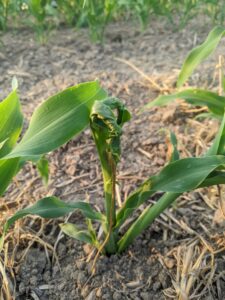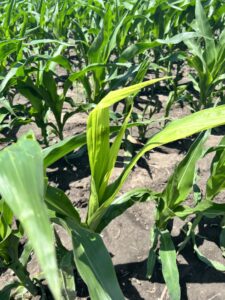What is buggy whipping?
“Buggy whipping” is the term for when leaves in the corn whorl become crinkled and fail to unfurl (Figure 1) properly. It can also be referred to as “twisted whorl syndrome” or “rapid growth syndrome”. Often these crinkled leaves bend toward the ground, resulting in an appearance some liken to a buggy whip. Sweet corn plants with buggy whipping symptoms will usually appear stunted compared to unaffected plants in the same field. The crinkled, compressed leaves temporarily prevent new leaves from emerging from the whorl. Crinkled and contorted leaves are also less efficient at intercepting sunlight needed for photosynthesis, which can delay crop development. Symptoms are typically not uniform across a field, with symptomatic plants growing alongside unaffected plants.

Figure 1. Buggy whipping injury on sweet corn following treatment with metolachlor, a Group 15 herbicide (Photo by Stephen L. Meyers).
What causes “buggy whipping”?
Buggy whipping can occur after applying a Group 15 herbicide, such as products containing metolachlor, acetochlor, or pyroxasulfone. However, the symptoms can also be linked to periods of rapid growth- especially following stressful growing conditions. Some examples include drought followed by irrigation/rainfall or cold soil or air temperatures followed by a warm-up. Others report that cultivar selection plays a role, with some varieties more prone to buggy whipping than others.
What are the impacts?
Although seeing sweet corn with this symptom can be unsettling, it is typically not a cause for concern. The observed symptoms are not uncommon in corn entering the rapid growth stage around the V5 to V6 leaf stage. Within a week’s time, most symptomatic plants will unfurl. The affected leaves will continue to grow and expand, but they may still remain somewhat crinkled. Shortly after unfurling, new growth may appear yellow (Figure 2). This is just a result of insufficient sunlight reaching the newest leaves while they are trapped in the whorl. They will green up soon. Affected plants may be slightly delayed and have a crinkled appearance, but yield is usually not decreased in multi-harvest or “two-pass” sweet corn. However, for once-over harvested sweet corn, ears from these plants may not be at the perfect eating stage at the same time as the rest of the field and could represent a decrease in yield or quality.
